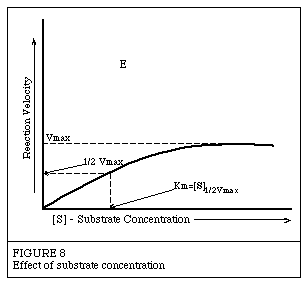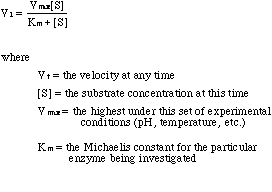Introduction to EnzymesThe following has been excerpted from a very popular Worthington publication which was originally published in 1972 as the Manual of Clinical Enzyme Measurements. While some of the presentation may seem somewhat dated, the basic concepts are still helpful for researchers who must use enzymes but who have little background in enzymology. Substrate ConcentrationIt has been shown experimentally that if the amount of the enzyme is kept constant and the substrate concentration is then gradually increased, the reaction velocity will increase until it reaches a maximum. After this point, increases in substrate concentration will not increase the velocity (delta A/delta T). This is represented graphically in Figure 8.  It is theorized that when this maximum velocity had been reached, all of the available enzyme has been converted to ES, the enzyme substrate complex. This point on the graph is designated Vmax. Using this maximum velocity and equation (7), Michaelis developed a set of mathematical expressions to calculate enzyme activity in terms of reaction speed from measurable laboratory data.  The Michaelis constant Km is defined as the substrate concentration at 1/2 the maximum velocity. This is shown in Figure 8. Using this constant and the fact that Km can also be defined as: Km=K-1 + K2 / K+1
K+1, K-1 and K+2 being the rate constants from equation (7). Michaelis developed the following
Next: Effects of Inhibitors |

 Place Order
Place Order
 PDF version of Introduction to Enzymes
PDF version of Introduction to Enzymes